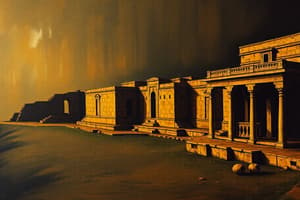Podcast
Questions and Answers
In which century CE were the first significant discoveries of the Indus Valley Civilization made?
In which century CE were the first significant discoveries of the Indus Valley Civilization made?
- 20th century
- 18th century
- 19th century (correct)
- 16th century
What is the length of the area along the banks of the Indus River and beyond where the Indus Valley Civilization flourished?
What is the length of the area along the banks of the Indus River and beyond where the Indus Valley Civilization flourished?
- 900 miles (1,500 km) (correct)
- 1500 miles (2,400 km)
- 500 miles (800 km)
- 1200 miles (1,900 km)
What is the approximate duration of the Indus Valley Civilization?
What is the approximate duration of the Indus Valley Civilization?
- 3000 BCE to 1000 BCE
- 7000 BCE to 600 BCE
- 2500 BCE to 1500 BCE
- 3300 BCE to 1300 BCE (correct)
What is the name of the two prominent cities of the Indus Valley Civilization discovered by British colonial officials?
What is the name of the two prominent cities of the Indus Valley Civilization discovered by British colonial officials?
What is a characteristic of the Indus Valley Civilization's society and culture?
What is a characteristic of the Indus Valley Civilization's society and culture?
What is an example of the crafts practiced by the Indus Valley Civilization?
What is an example of the crafts practiced by the Indus Valley Civilization?
What was the primary purpose of the large tanks in the Indus Valley Civilization's irrigation system?
What was the primary purpose of the large tanks in the Indus Valley Civilization's irrigation system?
What is the primary obstacle in understanding the institutions, governance, and social structures of the Indus Valley Civilization?
What is the primary obstacle in understanding the institutions, governance, and social structures of the Indus Valley Civilization?
What is the term used to describe the process of cities being abandoned during the decline of the Indus Valley Civilization?
What is the term used to describe the process of cities being abandoned during the decline of the Indus Valley Civilization?
Which of the following is NOT a theory suggested to contribute to the decline of the Indus Valley Civilization?
Which of the following is NOT a theory suggested to contribute to the decline of the Indus Valley Civilization?
What was the primary material used for clothing and textiles in the Indus Valley Civilization?
What was the primary material used for clothing and textiles in the Indus Valley Civilization?
What is the current status of the Indus script?
What is the current status of the Indus script?
Study Notes
Ancient Indian History: The Indus Valley Civilization
The Indus Valley Civilization, also known as the Harappan Civilization, is an archaeological and cultural-historical entity that flourished in the northern region of the Indian subcontinent from approximately 7000 to 600 BCE. This civilization is named after the Indus River, where many of its most significant sites have been discovered. Its territory extended from modern-day Pakistan to northwest India, spanning a vast area of 900 miles (1,500 km) along the banks of the Indus River and beyond.
Geography and Time-frame
The Indus Valley Civilization is believed to have been established around 3300 BCE and lasted until around 1300 BCE. The civilization's existence was initially not well-known, with the first significant discoveries being made in the 19th century CE. British colonial officials in India, while constructing a railway connecting Lahore and Karachi, stumbled upon the ruins of Harappa and Mohenjo-Daro, two of the most prominent cities of the Indus Valley Civilization.
Society and Culture
The Indus Valley Civilization was a complex, urbanized society that was involved in sophisticated urban planning and large-scale building projects, such as large baths and numerous crafts, including pottery-making, metallurgy, lapidary (stone and gem) arts, and brick-making. The society utilized an irrigation system that involved storing water in large tanks, which allowed them to grow various crops like barley, wheat, sesame, and various legumes, as well as cotton for clothing and textiles. The people raised domesticated animals, including cattle, water buffalo, pigs, sheep, and goats.
Writing System and Script
The Indus Valley Civilization is particularly intriguing because of its unresolved script. While some scholars believe that the symbols and inscriptions on the artifacts represent a writing system, others remain uncertain due to the difficulties in deciphering and interpreting the symbols. To this day, the Indus script remains undeciphered, which has limited our understanding of the civilization's institutions, governance, and social structures.
Demise and Decline
The Indus Valley Civilization began to decline around 1900-1500 BCE, and its cities were steadily abandoned, leading to a process of "deurbanization". The reasons for the civilization's decline are still a subject of debate among historians. Some theories suggest that climate change, the drying up of the Sarasvati River, an alteration in the path of the monsoon, overpopulation of the cities, or a decline in trade with Egypt and Mesopotamia may have contributed to the civilization's downfall. However, the exact cause remains unclear.
In conclusion, the Indus Valley Civilization remains a fascinating and enigmatic part of ancient Indian history. Despite the many questions that remain, archaeological discoveries and ongoing research continue to shed light on this early urban civilization and its significant contributions to the development of human societies.
Studying That Suits You
Use AI to generate personalized quizzes and flashcards to suit your learning preferences.
Description
Explore the ancient Indus Valley Civilization, a complex urbanized society that flourished in the northern region of the Indian subcontinent from 7000 to 600 BCE. Learn about its geography, society, culture, writing system, and decline.




